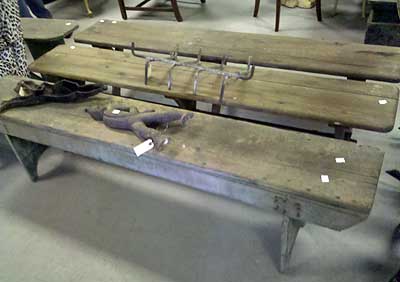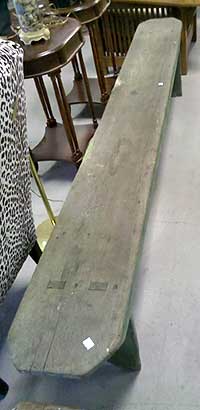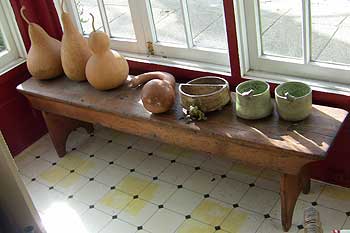The four weather-beaten wooden benches were placed prominently near the front among other disparate items, but close to the chairs so auction-goers could see them. I had missed them, though, because I was not in the market for seating.
I came across them later during the preview when I had some time to spare before the auction began. They looked as if they’d been dogged by the weather, which had stripped them of the wood grain that had once been their pedigree . Now they were as gray as a cloudy sky waiting for rain – or in this case heavy bidders.

I bought a bench like them years ago when I first started going to auctions. It still had its natural grain, but it, too, had picked up some nicks, water rings and other marks along the way. That’s what drew me to it: The bench had the wear of the family that presumably had used it. I could imagine them seated around a table enjoying each other and their meal.
Like these, my bench was almost 5 feet long, and I had no idea where I’d put it in my home but I loved the look of it. I don’t even remember how I got it into my car but somehow it fitted, with the help of an auction staffer.
It now has a place on my enclosed front porch, and holds some lovely artsy planters I got at auction and gourds I picked up at a farm one summer (I was so taken with them that I bought too many). I never considered putting the bench in my front or back yard because I didn’t want it to lose its color like the ones at the auction.

These are considered primitive farmhouse benches and the real ones were made by hand. Primitive furniture is also referred to as American country furniture, according to Collectors Weekly, and was first made before furniture was mass-produced in the 19th century.
The earliest primitive furniture was made in the 18th century and was distinguished by such characteristics as its dovetail and mortise and tendon joints, according to the article. The furniture was crafted by farmers based on what a neighbor requested.
My bench and the ones at the auction were not that old, but the craftsmanship appeared to be similar. They all looked to be handmade with the mortise and tendon joints and nails.

My auction buddy Janet did not attend the sale, but she mentioned later that she had seen the benches and was interested in one for her home. I’m sure she would have used it as a decorative item just as I have done.
Farmhouse benches were plentiful on the web, and many of the ones I came across had been sold. Some were listed as primitive and distressed, but they looked new compared to the ones at the auction. The sale prices ranged from about $80 to $150. One retail outlet was selling new ones for $500.
I wasn’t around when the benches sold, but given their condition, I suspect that someone got a good deal on all of them.
I haven’t done much in decorating with my bench. How would you incorporate one into your décor?
